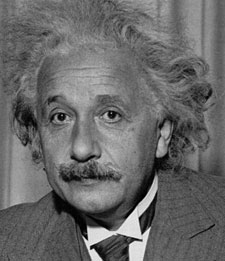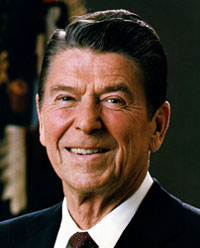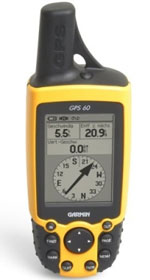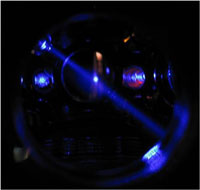
GPS: Global Positioning System
When the American military made the global positioning system, GPS, they had to adjust for the effects of Einstein's Theory of Relativity. This is because clocks on the satellites run a little faster than clocks here on Earth.

Albert Einstein, one of the twentieth century’s most important scientists, was born on March 14th, 1879 in the southern Germany city of Ulm and died in Princeton, USA on April 18th 1955, where he spent the last ten years of his life.
In 1905, Albert Einstein published the Special Theory of Relativity. According to this theory the speed of light is always constant. Time and distance, however, will change under different circumstances; for example, at different speeds.
Eleven years later Einstein also published the General Theory of Relativity. This theory showed that the different celestial bodies pulled both space and time around them. It would say, for example, that time passes more slowly on a planet such as Earth, than it does out in space.
The idea that time and space can change length, overturned our entire worldview. It meant that the laws of classical physics only apply at low speeds and short distances. The consequences of the two theories conflict with our ordinary experiences. This is because the effects are only apparent under conditions that we never experience ourselves. Einstein says that time goes faster the less the influence of gravity there is. But how can we believe that a clock goes slower on Earth than in space?
Over the course of time, many have devised various experiments to determine whether the two theories are correct. In 1955, the German-American physicist Friedwardt Winterberg suggested an experiment, in which extremely accurate atomic clocks should be placed on satellites to see if they would go faster than clocks on Earth. The experiment was of course very expensive and was never carried out.

On October 4th, 1957 the then Soviet Union launched the world’s first satellite, Sputnik 1.
The Cold War and Sputnik
But at the same time the Cold War began to develop. In both the Soviet Union and the USA the military produced more and more nuclear weapons, to be sure that the enemy did not become stronger than themselves. The more accurately the nuclear weapons could hit their targets on the other side of the more dangerous they were. Therefore, it suddenly important to calculate exact positions. And that is why the American military began to improve its navigation tools.
In 1957, the Russians launched Sputnik. The Americans kept track of the satellite and began to imagine how they might use information from satellites to navigate with. Little by little, they tried different solutions. In 1973, the various parts of the American meeting held a meeting, where they combined their knowledge. At the meeting it was decided to use satellites to make a "GPS": a "Global Positioning System". That is to say, a system, which can give the users exact position, anywhere on the globe.
Immediately afterwards, they began to build satellites and send them into space. But in order to coordinate the various signals from the satellites, it was necessary to have incredibly accurate clocks. Thus, Winterberg's experiment became a reality.

Ronald W. Reagan (February 6, 1911–June 5, 2004) was an actor, Republican, politician, former governor of California and 40th president of the United States through two elections from 1981 to 1989.
Einstein was right
An Einstein was right: The clocks on board the satellites actually went faster than clocks here on Earth and the engineers had to adjust for this. When the system was finally ready to be used 1993, the Cold War was over. But the GPS system had been created and it can show us the across the globe.
Initially, it was intended that only the military would have access to the GPS system But in 1983 a Korean plane made a navigation error and was shot down over the Soviet Union. Following this incident, President Reagan decided that the system should also be accessible to ordinary people. During the first years, there was a code on the open signal so it was very imprecise. But the code was removed in 2000 and it became customary to buy GPS receivers to find your way.
GPS can also be used for other things. One example is geocaching: A kind of treasure hunt, where you find small treasures that others have set out using a GPS receiver.
 How GPS works
How GPS works
A GPS receiver here on Earth receives signals from satellites out in space and uses these to figure out where it is. If the satellite is programmed send a signal at 12, then the GPS receiver can see how long it takes for the signal to arrive.
The radio signal consists of electromagnetic waves, like light, so the speed of the signal is also constant, like light's. The GPS receiver also knows both the speed of the signal and the time it took to reach the Earth, and knows therefore exactly how far away the satellite is.
The GPS receiver knows precisely where the satellite is in relation to the Earth. This is because all satellites fly in fixed orbits. Inside the GPS receiver is a little almanac, which is constantly telling it where they are.
But the radio signal only says something about the distance of the satellite - not which direction it came from. Therefore, the GPS receiver has to be in contact with at least three satellites. Then it gets a crossing point, which shows its own position.
 GPS receivers are slightly inaccurate, because of their clocks
GPS receivers are slightly inaccurate, because of their clocks
The clocks that are out in the satellites are called atomic clocks. They work by counting the oscillations of cesium and rubidium atoms. Their drift is only one second over a million years. When the GPS receiver measures how long it takes the satellite radio signals to reach down to Earth it should also use an atomic clock, to make it absolutely correct.
But atomic clocks are expensive. A single clock costs between 50 and 100,000 dollars. That is why there are only ordinary, cheap clocks in GPS receivers. And that is why GPS receivers should have contact with at least four satellites at a time in order to work properly. The distance from the crossing point, which the GPS receiver calculates, to the fourth satellite can tell how off the measurement is. In this way, the cheap watch is always setting the time for itself.
|

 Satellites and the relativity theory
Satellites and the relativity theory